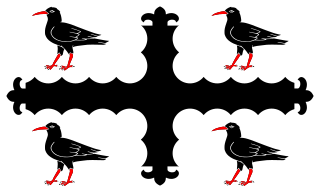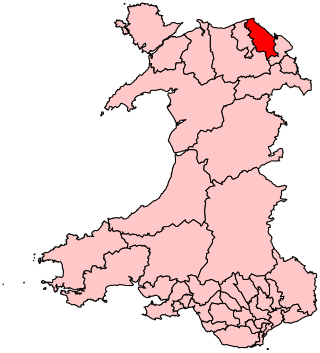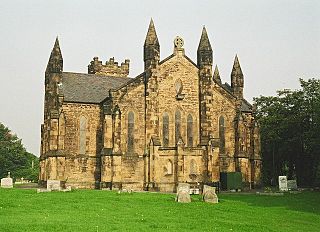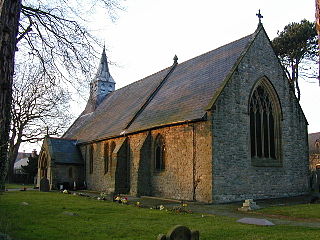
Flintshire is a county in the north-east of Wales. It borders England to the east, Denbighshire to the west and Wrexham County Borough to the south. It is named after the historic county of the same name which has notably different borders. Flintshire is considered part of the Welsh Marches and formed part of the historic Earldom of Chester and Flint. The county is governed by Flintshire County Council which has its main offices in County Hall, Mold.

Flintshire, also known as the County of Flint, is one of Wales' thirteen historic counties, and a former administrative county. It mostly lies on the north-east coast of Wales.

Mold is a town and community in Flintshire, Wales, on the River Alyn. It is the county town and administrative seat of Flintshire County Council, as it was of Clwyd from 1974 to 1996. According to the 2011 UK census, it had a population of 10,058. A 2019 estimate puts it at 10,123.

Flintshire County Council is the unitary local authority for the county of Flintshire, one of the principal areas of Wales. It is based at County Hall in Mold.

Delyn is a constituency represented in the House of Commons of the UK Parliament since 2019 by Rob Roberts, who was elected as a Conservative, but currently sits as an Independent following sexual harassment allegations.

Bagillt is a market town and community in Flintshire, Wales. The town overlooks the Dee Estuary and is between the towns of Holywell and Flint. At the 2001 Census the population was recorded as 3,918, increasing to 4,165 at the 2011 census. The community also includes the villages of Walwen and Whelston. Landmark locations such as Gemma Rushes bath.

Nannerch is a village and community in Flintshire, Wales, located within the Clwydian Range and Dee Valley Area of Outstanding Natural Beauty. At the 2001 Census the population of Nannerch was 531, reducing to 496 in 2011.

Cilcain is a village and community, near Mold in Flintshire, north-east Wales. The village has an industrial history and includes the Millennium Woods, a post office, a public house, a parish church, a primary school and a village hall.

Pantymwyn is a small village just outside Mold in Flintshire, Wales, in the community of Gwernaffield with Pantymwyn.

Ysceifiog, also written Ysgeifiog, is a small village, community and parish in Flintshire, Wales. It lies on a back road just north of the A541 highway between Nannerch and Caerwys. The name translates roughly as "a place where elder trees grow".

Greenfield is a village in the community of Holywell, Flintshire, north-east Wales, on the edge of the River Dee estuary. At the time of the 2001 census it had a population of 2,741, which remained unchanged in the 2011 census.

Cadole is a village in Flintshire, Wales. It lies west of Gwernymynydd and Mold, south of Gwernaffield and to the east of the Clwydian Range, part of an Area of Outstanding Natural Beauty.

The Mold gold cape is a ceremonial cape of solid sheet-gold from Wales dating from about 1900–1600 BC in the British Bronze Age. It was found at Bryn yr Ellyllon burial mound near Mold, Flintshire in 1833.

Mold Castle, also known as Bailey Hill in the town of Mold, Flintshire, north-east Wales, is a motte-and-bailey castle erected around 1072, probably by the Norman Robert de Montalt under instructions from Hugh d'Avranches, Earl of Chester. Little remains except the mound on which the motte was built. It stands close to the 15th-century parish church, St Mary's Church near the centre of the town.

Gwernaffield is a village and electoral ward in Flintshire, Wales. It lies about three miles west of Mold on the eastern side of the Clwydian Range. The village is part of the community of Gwernaffield with Pantymwyn, which has an area of 7.53 km2 and is bordered by the River Alyn on three sides. The community includes the neighbouring village of Pantymwyn and had a population of 1,851 at the time of the 2001 census, increasing to 1,942 at the 2011 census. The name of the village comes from gwern, feld and gwaun. Gwernaffield, which adjoins Pantymwyn, Itself had a population of around 900.

Holywell Junction railway station was a junction station located on the north-eastern edge of Holywell and Greenfield, in Flintshire, Wales, on the estuary of the River Dee.

Gwernaffield with Pantymwyn is a community in Flintshire, Wales with a population of 1942 as of the 2011 UK census. It includes the villages of Gwernaffield and Pantymwyn.

County Hall is a municipal facility at Raikes Lane in Mold, Flintshire. It was the headquarters of the old Flintshire County Council from 1967 to 1974, the headquarters of Clwyd County Council from 1974 to 1996 and has been the headquarters of the new Flintshire County Council since 1996.

Mold Town Hall is a municipal structure in Earl Road in Mold, Wales. The town hall, which serves as the meeting place of Mold Town Council, is a Grade II listed building.






















